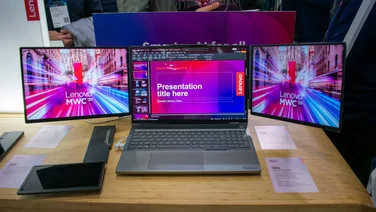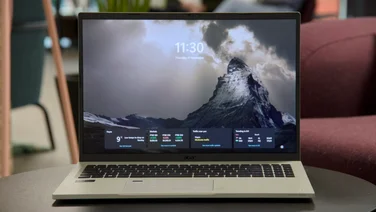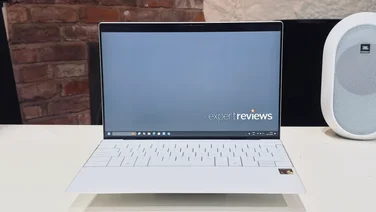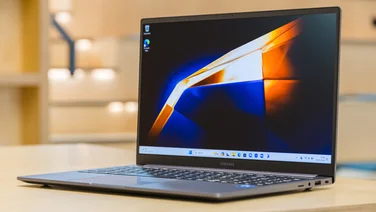To help us provide you with free impartial advice, we may earn a commission if you buy through links on our site. Learn more






















- Good battery life
- Excellent UHD display
- Top-end Core i7 processor
- No Windows Hello facial recognition
- Touchpad's haptic action is odd
- Obscure touchpad and fingerprint scanner
For a laptop manufacturer to be awarded an unqualified recommendation for its flagship 2-in-1 machine is akin to a German car maker clocking the fastest time around the Nürburgring for its compact executive sports saloon. Just as BMW, Audi and Mercedes want to brag that their car is best, so the likes of Lenovo, HP, Asus and Dell want to claim their sub-£2,000 2-in-1 (thats a laptop that can be folded back on itself through 360 degrees to form a tablet) is the leader of the pack.
The Yoga 9i 14in convertible is Lenovo’s latest effort to seize the crown in this hotly contested segment of the premium laptop market. But does it have what it takes to beat the opposition around the laptop Nordschleife?
READ NEXT: The best laptops to buy right now
Lenovo Yoga 9i 14in review: What you need to know
The new Yoga 9i 14in range with 11th-gen Intel silicon starts at £1,099 for the Core i5 model with 8GB of RAM, a 512GB SSD and a Full HD display. Cough up £1,469 and you get the Core i7 model but with a 256GB SSD. Up that to £1,549 and you also get a 512GB SSD, 16GB of RAM and a UHD display.






















Top of the line is the £1,700 Shadow Black model which adds a 1TB SSD into the mix and a leather lid cover. The model weve been sent is the top of the line Shadow Black machine but with a 512GB SSD.
Lenovo Yoga 9i 14in review: Competition
The obvious competitor is HPs 13.5-inch Spectre x360, which is little short of a masterclass in laptop design. Compact, lightweight and stunning to look at and packing a glorious OLED UHD display it also comes with a stylus like this new Lenovo.
The Bang & Olufsen-branded sound system is not as impressive as the name would suggest though. Add an 11th-gen Core i7 and 1TB SSD into the deal for £1,700 and the x360 is a compelling offering.
Generally considered the best of the breed, the 13.4in Dells XPS 13 2-in-1 has also just been revamped with the addition of 11th-gen Intel chips. You still get a fine keyboard and a 16:10 display with very narrow bezels. The slightly squarer screen makes the XPS more usable as a tablet for creative work than the 16:9 Yoga 9i, too.
Prices range from £1,400 for the Core i5 machine with 8GB of RAM to £2,200 for an i7-based version with 32GB of RAM, a UHD display and a 1TB SSD. If you want a stylus then Dells Premium Active Pen will cost you an eye-watering £90 but there is nowhere to stow it.
Asus 13.3-inch ZenBook Flip S is another strong contender. With a vibrant OLED display housed in a slim and light body, it gives the Spectre a run for its money in the aesthetics department thanks to a gorgeous black and red-copper colour scheme, and it uses the latest 11th-gen Intel chips.
Battery life was less impressive though and our review raised some worrying issues with thermal management. It is the most costly device here, the only (admittedly high-end) model costing around £1,800 but also the lightest of the bunch at 1.2kg.
If you want something to use more as a tablet rather than a laptop then either Microsofts Surface Pro 7 or Surface Book 3 are worth considering. Right now, the 10th-gen Core i7 Surface Pro 7 with a 256GB SSD and 16GB of RAM is on offer for a mere £1,200. At less than 800g it makes regular laptops feel positively lardy and the optional Type Cover adds little to the size and weight. Outright performance can’t match the 2-in-1s listed above but, if having a reasonable size (12.3in) screen in a super-portable form is your priority, it is a solid choice.
Lenovo Yoga 9i 14in review: Design & key features
At 210.9 x 318.4 x 15.3mm (WDH) and 1.34kg, the Yoga 9i isnt the lightest or thinnest 2-in-1 weve looked at that accolade goes to the Asus ZenBook Flip Z but the differences between it and the rest of the competition are pretty marginal. Theres no doubting the underlying structural integrity of the Lenovo, however. It feels very solid.
Compared with the somewhat baroque HP and Asus machines the Yoga 9i is a little plain. Detracting from the modern, minimalist styling is the lids leather covering. It feels more like plastic which rather undermines the point. The screen bezels could be slimmer, too: 5mm at the side is great, 8mm at the top is OK but 13mm at the bottom is nothing to write home about. Cleverly, Lenovo has built the Yoga 9is speaker array into the lid hinge so it faces towards you in laptop mode and points up when in tent or tablet mode.
Parading along the left side of the Yoga 9i you will find one USB Type-A 3.1 Gen 2 (10Gbits/sec) and two Type-C ports, both of which support Thunderbolt 4 and one of which you will need to charge the laptop. Theres also a 3.5mm audio jack. On the right-hand side, theres just a power button. Wireless connectivity is handled by Intels increasingly common AX201 card, which supports Wi-Fi 6 and Bluetooth 5.






















The bundled Lenovo Active Pen is garaged in a slot at the rear just behind the power button. The slot is unobtrusive and secure so if you dont use it, you can just forget about it. The stylus supports 4,096 pressure levels and, according to Lenovo, a 15-minute charge will keep it powered for 90 minutes. I found the pen generally very capable, although it is rather slender, which makes it harder to hold for prolonged periods than other, thicker pens I’ve used.
This being a Lenovo its no surprise that the keyboard is absolutely solid and the key action supremely precise if very shallow. There is however one design choice that I am not a fan of.
The entire width of the palm rest is made from a single piece of tempered glass. This means you cant feel the boundaries of either the trackpad or the fingerprint scanner and, thanks to both being marked by a shiny black line against a matte black background you cant see their outline unless the light is reflecting off the palm rest just so. This makes using either a hit-and-miss affair.






















Once you’ve found the trackpad, you may not like the click action. On the Yoga 9i Shadow Black, its haptic like the Force Touchpad on modern MacBooks but gives a rather vague, unnatural-feeling buzz when pressed. Perhaps familiarity will soften my negative opinion but call me old-fashioned Id rather have a conventional touchpad. Luckily, you can have this if you dont insist on buying the Shadow Black model.
The elusive fingerprint scanner made the absence of a Windows Hello compatible IR webcam all the more keenly felt. On the upside, the 720p webcam does have a privacy shutter and shoots pretty decent video.
READ NEXT: The best laptops to buy right now
Lenovo Yoga 9i 14in review: Display and Audio
The 14in 3,840 x 2,160 IPS display ticks all the right technical boxes. The maximum brightness of 489cd/m2, sRGB coverage of 99.3%, contrast ratio of 1,574:1 and an average Delta E colour accuracy of 0.33 are all on the money for a premium laptop.
At 315dpi it is impressively sharp, too. It may not pop at you like the OLED displays used by Asus and HP but it does support Dolby Vision, which is useful if you want to watch the increasing amount of compatible HDR content on the likes of Netflix.






















Leonovo calls the speaker assembly built into the hinge a Rotating Soundbar. That is not wholly hyperbole because the sound it produces is very impressive. I expected good things on the back of my experience with the Lenovo Yoga Slim 7 and the sound produced by the Yoga i9 is much the same but with even more volume and bass.
The combination of that bright UHD display and powerful speaker system makes the Yoga 9i a media machine par excellence.
Lenovo Yoga 9i 14in review: Performance & Battery Life
Running the show is an 11th generation Intel Core i7-1185G7 quad-core processor with integrated Iris Xe graphics and 16GB of soldered LPDDR4x 4,266MHz RAM. As announced by the only sticker on the palm rest the Lenovo Yoga i9 conforms to Intels new Evo platform specifications.


As you can see the Yoga 9i just shades the Core i7 1165G-powered Dell XPS 13 in our 4K media test and in the GeekBench 5 test.
The new Core i7 clearly has the chops for everything bar demanding triple-A games played at high resolutions. To put that into a real-world context, Doom ran at an average of 49fps at 1,280 x 720, 28fs at 1,920 x 1,980 but at a glacial 7fps at 3,840 x 2,160.

If you are wondering what the difference is between the Core i7-1185G7 and Core i7-1165G7, the answer is that the former has a base frequency of 3.0GHz to the latters 2.8GHz and a Turbo-Boost frequency of 4.8GHz rather than 4.7GHz.
AMDs latest Ryzen 7 4800U and Apples M1 silicon can do rather better, especially when it comes to multi-core operations but you cant get them in a premium 2-in-1, so why worry?
Squeezing powerful chipsets into thin notebooks can raise issues with heat management but the dual fans in the Lenovo Yoga 9i do a sterling job in keeping things cool even if they are a little on the loud side at full speed. The 512GB Western Digital SN730 NVMe SSD in my review sample returned par-for-the-course read and write speeds of 2,785MB/s and 1,464MB/s respectively.

As for battery life, the 60Whr (7,820mAh) battery inside the Yoga 9i lasted 11hrs 35mins in our standardised battery run-down test, which is only a little shy of the Dell XPS 13 and not at all bad for a machine with a larger, higher-resolution display.
Lenovo Yoga 9i 14in review: Verdict
Is the Yoga 9i good enough for an outright class win? Not quite. I found the trackpad and fingerprint scanner just too bothersome. Is the HP Spectre the best then? Again, no. While the HPs OLED screen is a delight, the Yoga 9i’s display runs it a very close second and is bigger. And the Yoga has a better sound system and superior battery life.
The Dell then? None of the competition has the XPS 13s super-slim screen bezels but you dont get a pen let alone a slot for one, or a Type-A USB port for that matter. And what about Asus ZenBook Flip? The thermal management issues in our review sample would give me pause if I planned on intensive use.
If it was my money I would plump for either the Dell XPS 13 because of its super thin bezels or the Yoga 9i because of the speaker quality but both machines have their benefits and drawbacks.






















| Lenovo Yoga 9i Shadow Black specifications | |
|---|---|
| Processor | Intel Core i7-1185G7 |
| RAM | 16GB |
| Additional memory slots | No |
| Max. memory | 16GB |
| Graphics adapter | Intel Iris Xe |
| Graphics memory | Shared |
| Storage | 512GB |
| Screen size (in) | 14.0 |
| Screen resolution | 3840 x 2160 |
| Pixel density (PPI) | 315 |
| Screen type | LCD IPS |
| Touchscreen | Yes |
| Pointing devices | Toucpad, Active Pen |
| Optical drive | No |
| Memory card slot | No |
| 3.5mm audio jack | Yes |
| Graphics outputs | USB-C (Thunderbolt 4) |
| Other ports | USB Type-A 3.1, 2 x USB Type-C Thunderbolt 4 |
| Web Cam | 720p |
| Speakers | Stereo Dolby Atmos |
| Wi-Fi | Wi-Fi 6 (802.11ax) |
| Bluetooth | Bluetooth 5.0 |
| NFC | No |
| Dimensions, mm (WDH) | 318 x 211 x 15 |
| Weight (kg) – with keyboard where applicable | 1.34 |
| Battery size (Wh) | 60 |
| Operating system | Windows 10 Home |









